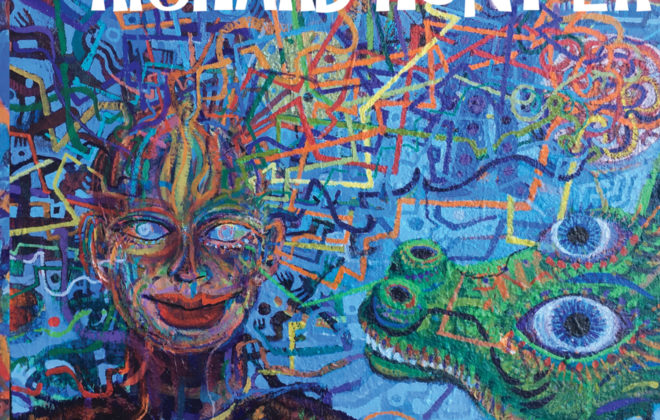
Rob Papparozzi
You’ve heard Rob Papparozzi’s work plenty of times if you own a cassette deck, or a CD player, or a television, or if you go to the movies, or listen to the radio; but you probably don’t know his name unless you’re deeply into the harmonica. He’s a studio pro with some of the best credentials in the business, but his work as frontman has been limited mostly to the New York area.
I met Rob in the early 1980’s, not long after my book Jazz Harp was published. Rob called me up from New Jersey and told me that he was visiting Cape Cod with his wife Sandy; could he drop by and see me? He was a great guy, and he played solid blues harmonica with a strong Butterfield influence (his demo tape had some well-recorded and played Butterfield covers from the Pigboy Crabshaw era on it). He was also nice enough to tell me that my book solved some problems he’d been having with the chromatic harp, which I was glad to hear. He was working a day job as a parole officer for juvenile offenders and performing nights and weekends, and he wanted to move into the music business fulltime.
Rob was so nice and laid back in person that I didn’t see the incredible depth of his determination. He understood clearly that he had to master the music business, his instrument, and skills like sight reading in order to become a competitive professional in the New York market, and he very methodically set about learning all those things. He studied chromatic harmonica with Cham-ber Huang and Robert Bonfiglio, two of the best classical players in the world. He studied blues and jazz on his own, learning from the records of Toots Thielemans, Butterfield, Norton Buffalo, Little Walter and James Cotton. He understood early on that playing harmonica alone would not earn him a real living, even in a market as big as New York, and he worked as hard on his singing and his keyboard skills as he did on harmonica.
Music is a hard business; even so, a pleasant personality is a real asset in studio work, where you’re locked in a small room with anywhere from 1 to 15 people for hours at a time, and abrasive personalities become problems for everyone very quickly. Rob’s mastery of the technical elements of his craft was matched by his ability to work with people, and he has become one of the most-employed harmonica players in New York. I find that every studio engineer and producer I meet in New York has worked with Rob. (It’s a little daunting when I try to scare up gigs for myself.)
I saw Rob most recently at the August 1997 SPAH convention. I played opposite him in a jam session, where he played killer blues, and attended his seminar on studio playing, where he played a bossa nova on chromatic harmonica beautifully. His career is testimony to the power of hard work, talent, and clear thinking; and to the power of music also, which you can hear in every note Rob plays.
You can hear Rob’s work as frontman now on two superb recordings from his R&B band The Hudson River Rats, which band also features the legendary drummer Bernard Purdie. You can also hear him with Slo-Leak, an R&B oriented outfit that features Harvey Brooks on bass and Danny Kortchmar on guitar, two players whose combined credits include too many Big Names to mention. If you live in or near New York City, you can also find Rob teaching at the Turtle Bay School (where he used to take lessons from Messrs. Huang and Bonfiglio). And for a partial list of Rob’s own credits, some of which you’ve undoubtedly heard already, take a look below.
Broadway: Big River, Shenandoah, Will Rogers Follies, 110 in the Shade, Memphis is Gone
Movies: Native Son, Straight out of Brooklyn, Tom & Huck, Ed
Artists: Cyndi Lauper, Roberta Flack, David Clayton Thomas,
Mick Taylor, Judy Collins, Dakota Staton, Bobby Mcferrin
Johnny Copeland, Bo Diddley
Jingles: Wendy’s, Pizza Hut, All, Tide, Ford, Dodge, Chevy, Pepsi,
Coke, Compaq, IBM, Tetley, Lipton, Levis, K-Mart and more..
TV: Cosby, Rocco’s Modern Life, Cinemax, HBO, Bump in the Night,
Martha Stewart, Nickolodeon, Shining Time Station, Reading Rainbow
Related Posts
Leave a Reply
You must be logged in to post a comment.
WHAT’S NEW
Categories
- Audio/Video
- Blog
- Blue Future
- Digitech RP Tricks and Tips
- Discography, CDs, Projects, Info, Notes
- Featured Video
- For the Beginner
- Gallery
- Hunter's Effects
- Hunter's Music
- Huntersounds for Fender Mustang
- Meet the Pros
- More Video
- MPH: Maw/Preston/Hunter
- My Three Big Contributions
- Player's Resources
- Pro Tips & Techniques
- Recommended Artists & Recordings
- Recommended Gear
- Recorded Performances
- Reviews, Interviews, Testimonials
- The Lucky One
- Uncategorized
- Upcoming Performances
- Zoom G3 Tips and Tricks
